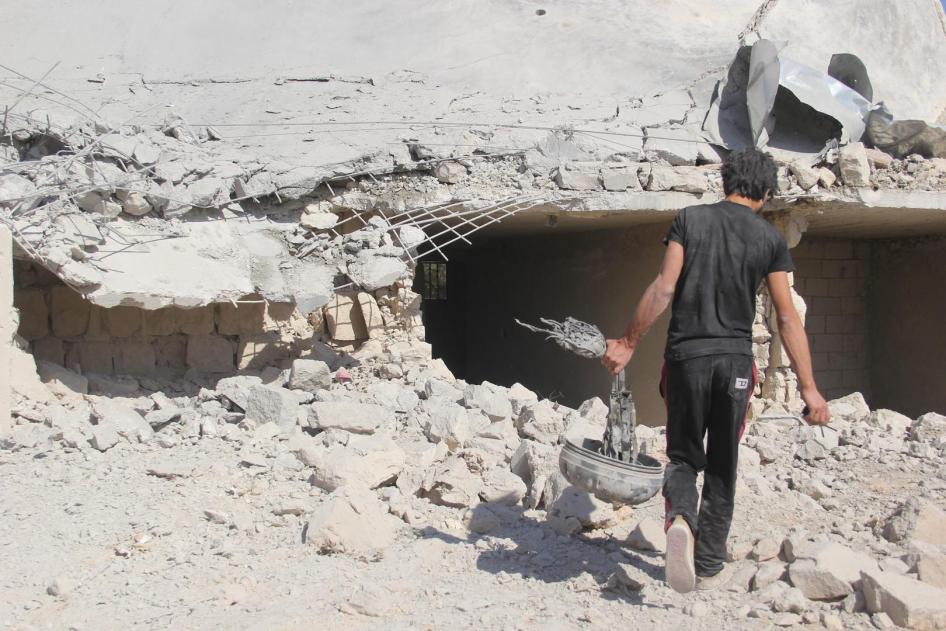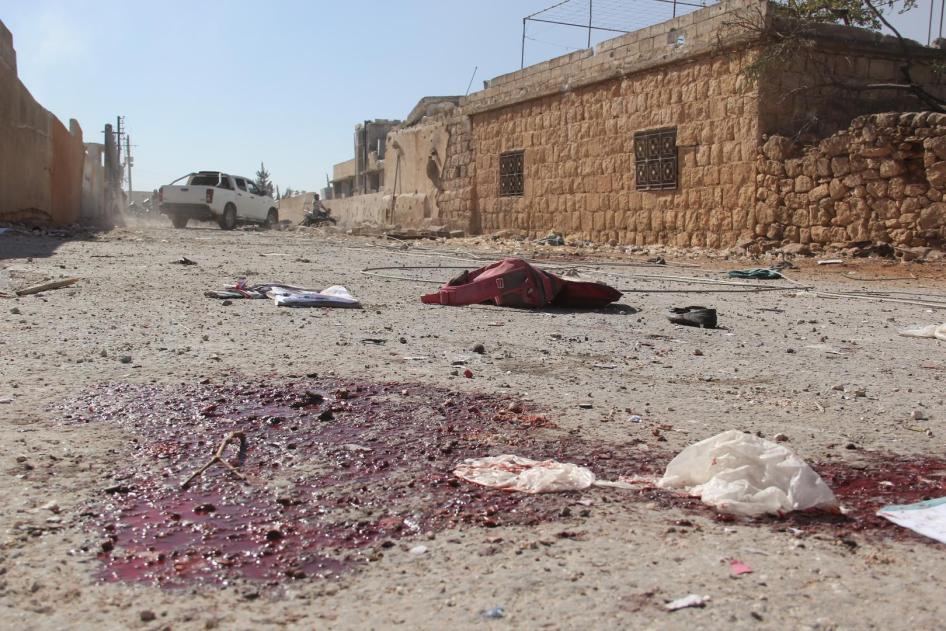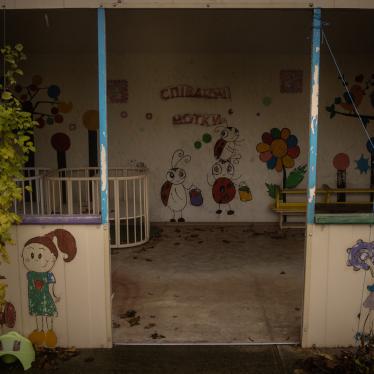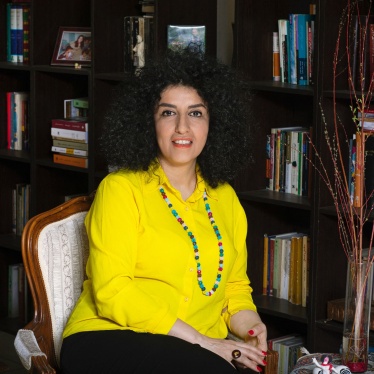(New York) – Airstrikes by the joint Russian-Syrian military operation that killed dozens of civilians, mostly schoolchildren, in the northern, opposition-controlled Syrian governorate of Idlib on October 26, 2016, could constitute a war crime, Human Rights Watch said today.
Witnesses told Human Rights Watch that the attacks struck a school complex in a residential area in the middle of the town of Haas while children were in class. The complex included a kindergarten, an elementary school, two middle schools, and a secondary school. The attacks also hit other nearby civilian infrastructure.
“On a clear morning, warplanes attacked a large school compound while class was in session, and kept on bombing while children and teachers tried to flee,” said Bill Van Esveld, senior children’s rights researcher at Human Rights Watch. “The fresh horror of this attack on schoolchildren is a testament to the inadequacy of the international response to ongoing war crimes in Syria.”
A report on Syrian state television on October 26 quoted a military source as saying attacks targeting opposition positions in Haas had killed fighters, news wires reported. Witnesses told Human Rights Watch that there were no military objectives in or near the schools at the time and that all of the killed and injured were civilians.
Human Rights Watch interviewed by phone seven witnesses to the attack, analyzed several videos posted by opposition groups and news sites, and interviewed one of the videographers. “There were so many torn bodies on the ground,” he said. “And schoolbooks mixed with blood.”
Witnesses said that one jet aircraft began the attack after 10 a.m. and that a second aircraft continued the attacks, which lasted for about 20 to 30 minutes. Witnesses consistently described seeing bombs with parachutes, and counted between seven and nine explosions in Haas, concentrated on the school complex and roads leading to it.
Screen-grabs and videos that witnesses said were of the attack show an SU-24 aircraft flying at medium altitude dropping munitions that deployed parachutes during descent before detonating near the ground. Both the Russian and Syrian militaries conduct airstrikes using SU-24 series aircraft. Human Rights Watch is unable to independently authenticate the images but they are consistent with witness descriptions of the attack.
A videographer whose footage was posted to YouTube by a local media group told Human Rights Watch in a series of WhatsApp messages that he was 300 meters from the schools that were hit when he shot the video and that anti-aircraft fire heard on the videos was from opposition fighters outside Haas in Kafr Nabl, a town three kilometers away. He said that he went to the strike site after he shot the video and that there were no military objectives in or near the schools – and that to his knowledge there are no military objectives in Haas.
The attacks killed 14 children including 9 girls, 12 men, and 7 women, all civilians, according to the Violations Documentation Center, a Syrian monitoring group. The United Nations Children’s Fund (UNICEF) reported that the attack had killed 22 children. One resident told Human Rights Watch that the casualties included 22 children and 7 parents who came to pick up their children after the first of several bombs exploded, and that the death toll could rise among the more than 40 wounded, who have been sent to hospitals in Syria or evacuated to Antakya, Turkey.
The airstrikes were the deadliest on schools in Syria since April 2014, when an airstrike killed 30 children in a school in Idlib, UNICEF said. There were 60 attacks on schools in 2015, killing a total of 591 children. There had been 38 previous attacks on schools since the beginning of 2016 that had killed 32 children.
At around 10 a.m. on October 27, opposition fighters in besieged East Aleppo reportedly launched a rocket attack that hit a private school, The National School, in the Shahba’ neighborhood in government-controlled West Aleppo, killing at least three children according to one report and as many as six according to another, including three siblings from one family. The attack also wounded 14, according to Syrian news sources.
About 1.7 million Syrian children are out of school in the country due to the conflict, and one in three schools is closed due to destruction, use for military purposes, or to shelter displaced people. About 750,000 Syrian refugee children in the region are not in school.
On its Facebook page, the Russian Defense Ministry posted an aerial photograph of the school compound in Haas from a Russian drone, claiming that there was no damage to the roofs of the buildings and no crater from aerial bombs nearby. The Defense Ministry spokesman reiterated these claims and added that a “blast wave” would have “swept away” all school furniture, and that videos of the incident had been edited. However, the damage to the schoolyard visible in the aerial photograph is consistent with the above-the-ground detonation of a blast or enhanced blast munition, Human Rights Watch said.
Idlib province is largely controlled by the Army of Conquest, an alliance of armed opposition groups including the Fateh al-Sham Front, which changed its name from Jabhat al-Nusra after breaking off ties with Al-Qaeda earlier this year.
The repeated striking of a large school complex in a residential area indicate the attacks were unlawful, being either indiscriminate or deliberately targeting civilians, and possible war crimes, Human Rights Watch said. Serious violations of international humanitarian law (the laws of war), when committed with criminal intent, amount to war crimes. Criminal intent requires purposeful or reckless action.
Human Rights Watch has documented previous Syrian government airstrikes that killed schoolchildren and teachers, and destroyed school buildings. Human Rights Watch has also previously documented indiscriminate mortar, locally made rocket, and other artillery attacks by armed opposition groups in Damascus and Homs governorates that struck at or near school buses, schools, and universities that were in operation at the time, and car bombings that have targeted schools in government-held territory. The attacks killed civilians, including children.
Human Rights Watch has long called for a UN arms embargo, individual sanctions on those responsible for atrocities by all sides in Syria, and referral of the situation to the International Criminal Court (ICC).
Speaking to UN correspondents on October 27, UN Special Envoy for Global Education Gordon Brown urged the Security Council, in relation for the attack in Haas, to “ask the International Criminal Court [prosecutor] for an investigation into what is happening in Syrian schools and in Syria as a whole.” UN Secretary-General Ban Ki-moon also called for an investigation into the attack.
On October 27, Russian Foreign Affairs spokesperson Maria Zakharova called for an investigation and “demand[ed] all international organizations join the investigation without further delay.” The following day, she wrote on her Facebook page that photographs of the aftermath of the attack were “computer graphics.”
In 2014, Russia and China vetoed a Security Council resolution that would have given the ICC prosecutor a mandate to investigate serious crimes in Syria despite ongoing grave violations in the country. Russia vetoed a fifth resolution at the Security Council on the conflict in Syria on October 8, 2016, stonewalling efforts to stop Syrian-Russian airstrikes on civilians in East Aleppo.
In light of the UN Security Council’s failure to maintain international peace and security and protect civilians in Syria, UN member states should request an emergency special session of the General Assembly on Syria, Human Rights Watch said. During this session, the General Assembly should take steps to establish an investigative mechanism on serious crimes in Syria, with a view to preparing cases for future criminal prosecution.
“UN member states should work together for what the Security Council has failed to provide – an end to unlawful attacks on civilians,” said Van Esveld. “Otherwise Syrian schoolchildren and others will continue to suffer, and the consequences are unbearable to contemplate.”
Conclusions From Video Footage
Videos posted on YouTube by a local pro-opposition media group and SMART news showed bombs with white parachutes attached falling from the sky, followed by large explosions.
Another video posted by the media office of the Revolutionary Forces of Syria includes one segment showing an SU-24 aircraft in the sky. A second segment, filmed from the same vantage point, shows a column of smoke rising from buildings in the distance and an object falling, causing an explosion. The landscape and buildings visible in the video, including two water towers, appear to fit with satellite imagery of Haas. The video appears to have been filmed from a vantage point west of the school compound.
Video footage posted by opposition-affiliated groups also showed significant damage to several buildings, including the schools. One video shows significant blast damage to the compound wall of one of the schools and to the facades of several of the buildings inside the school complex. The damage is consistent with the above-the-ground detonation of a blast or enhanced blast munition, Human Rights Watch said.
Anti-aircraft fire can be heard in all three videos.
Conflict Intelligence Team, which analyzes public-source information on military attacks, identified the locations near Haas from which three videos were recorded that showed explosions in the school compound. Conflict Intelligence Team noted that satellite imagery showing the destruction of nearby houses was not included in images of the school compound taken by an unmanned aerial vehicle that were released by the Russian Defense Ministry, which claimed there was no evidence that the area had been attacked.
Witness Accounts
Bilal Bayoush, the videographer, who is a journalist with the Kafranbel Media Center, a local pro-opposition group, told Human Rights Watch via WhatsApp messages that he recorded the fifth bomb strike on film at a distance of 300 meters at 10:26 a.m. He arrived in the area after the attacks and identified the schools affected by the attack as a kindergarten, the Shahid Kamal Kale’ji elementary school, the Banin Haas and Haas Girls’ middle schools, and the Haas Public High School.
In response to questions about audible anti-aircraft fire in the video, Bayoush said opposition forces had stationed an anti-aircraft gun in olive groves in an area outside Haas, and believed that they had fired “at the planes and at the parachutes and [bombs], hoping they would explode in the air”:
They weren’t in Haas. They were in Kfar Nabl, which is three kilometers away. There was no military presence in Haas at all. There were seven strikes, all on the schools. I went there but at first couldn’t get close. The sentries then said that the attack was over. But a plane came back and struck three times. We finally went in and began to rescue people with the civil defense’s help. There were so many torn bodies on the ground. And schoolbooks mixed with blood. The bodies were taken to the grand mosque. Some parents were at the scene and they were screaming. I fell because of a rock while carrying an old injured woman. I broke my leg.
A video capture that Bayoush took and sent to Human Rights Watch appears to show a remnant of the bomb’s parachute system used in the attack. Bayoush said the remnant was retrieved from a civilian home near the schools.
Moussa Zaydan, a volunteer with the Syria Civil Defense, a search and rescue organization that operates in opposition-controlled Syria, said in a phone interview he received a notification from the Civil Defense by phone at 10:48 a.m. that an attack had begun and went to the area immediately:
Sentries told us there was a [plane] that struck three times on the northern side of Haas. While on our way there was another warplane on its way toward the town and [it] struck six times, targeting the main road leading to the campus where several elementary schools, high schools, and some training colleges are located. Some of the bombs fell directly on the schools, in the playground, and where classes are held. There were bodies on the ground that we tried to rescue. Students in grades one, two, up to grade nine. They weren’t targeting armed groups. The schools are in the middle of the town. Children were traumatized. When you ask them “Who’s your father?” “Where’s your home?” they wouldn’t answer.
Marwan Hmeiyed, a local journalist who documents the war in Syria, said in a phone interview that there were “around 300 to 400 students” attending class at the time, and that two schools were “razed to the ground and one was partially damaged.” In addition to the school complex, Hmeiyed said, the area hit by the attack included “a clinic, and a bakery, and a residential complex nearby.” The casualties were initially evacuated to the grand mosque, he said. “Some people were cursing [Syrian President] Bashar [al-Assad]. Some were praying. Some people were silent, it was so awful, they couldn’t say anything anymore.”
Hassan al-Younes, who lives near the school complex, said in a phone interview he saw bombs with parachutes falling on Haas and that eight, in all, had exploded. The students were in class when the first bomb hit the wall of one of the schools, and the rest of the students were then dismissed, but that “another plane in the sky” attacked again as they began evacuating. “Everyone panicked. Some students took refuge in the homes nearby. But they were targeted too. There was barely one minute or a minute-and-a-half between one strike and the next.” Al-Younes said:
The schools are actually still administered by the regime. The regime pays the salary of the teachers there. There’s absolutely no military presence, there are no military headquarters within the town, they’re all outside it. Now, the schools are destroyed and out of service. Students can’t go back to school. Even people don’t dare to send them back. I don’t know what to say. They kept bombing us while bodies of children were still in the street. We couldn’t save them.
“Mustafa,” a resident who said he did not want his real name to be used, said in a phone interview he was wounded in the leg when he went to the school complex after the first attack to look for his nephews, who attend class there:
The first strike was near the schools, followed by a second, third, and fourth strike on the schools. And three others on the roads leading to them. The [bombs] had parachutes. Everyone was screaming, parents began arriving to the scene. Bodies were scattered, people were injured, some even died in that street.
“Yasser,” another resident who did not want his real name to be used, also emphasized that there were no armed groups or military vehicles in the school area at the time. “It’s just homes and schools. There were no armed vehicles, nothing of that sort. It was just civilians, schools, kids, no more.”










